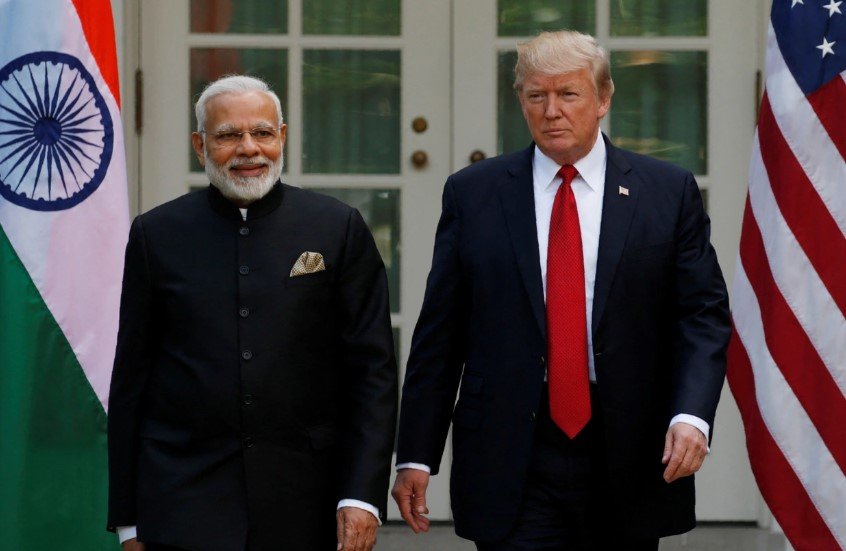White House confirms “very soon” breakthrough as New Delhi and Washington accelerate negotiations
The clock is ticking on a potential game-changing trade deal between India and the United States, with both sides signaling they’re just days away from a final agreement. With July 9 marked on calendars in bold, Washington says talks are moving at full throttle.
The announcement from the White House lands right in the middle of a whirlwind week for Indian diplomacy, with Foreign Minister S. Jaishankar on U.S. soil and Prime Minister Narendra Modi preparing for a five-nation tour.
White House: Deal Is “Very Close,” Final Touches Underway
It wasn’t a vague promise or some hazy bureaucratic chatter. White House Press Secretary Karoline Leavitt delivered a sharp, confident update when asked about the India-U.S. trade pact status during Tuesday’s press briefing.
She said the U.S. Commerce Department was actively finalizing details with its Indian counterparts and hinted at a near-term public announcement. “You’ll hear from the President and his trade team very soon,” she said, nodding to last week’s remark from President Trump himself.
One key word stood out: “finalising.” Not “planning” or “discussing.” That sent a clear signal to both trade watchers and political analysts.
And it’s no coincidence that this is happening while Jaishankar is in the U.S. attending QUAD meetings. Diplomacy is doing the heavy lifting in the background.

What’s at Stake for Both Countries
This bilateral trade agreement (BTA) is being treated less like paperwork and more like a cornerstone of future ties. It’s the first time in nearly two decades that such a deal has gained serious momentum.
For India, it could open new market access for pharmaceuticals, textiles, and digital services. For the U.S., it’s about lowering tariffs on manufacturing and agricultural goods.
There’s also a tech layer to this — especially around data flows, semiconductors, and AI cooperation.
Here’s what sources close to the talks have confirmed:
-
India is expected to ease certain tariffs on American medical devices and high-end tech goods.
-
The U.S. is likely to restore some Generalized System of Preferences (GSP) benefits to Indian exporters.
-
Digital trade frameworks are part of the side agreements, particularly around cloud infrastructure and cybersecurity cooperation.
The deal isn’t just trade for trade’s sake. It has strong geopolitical overtones.
Strategic Convergence Driving the Talks
Leavitt called India a “very strategic ally in the Asia Pacific.” That wasn’t just a throwaway line. In fact, it summed up why this deal feels bigger than numbers.
India and the U.S. are increasingly moving in lockstep — be it on maritime security, counterterrorism, or managing tensions in the Indo-Pacific.
The QUAD alliance is one layer. Defense tech transfer is another. And now, trade appears to be the third leg of a triangle that Washington wants to reinforce before the U.S. elections heat up.
For India, aligning with the U.S. on trade also sends a signal to China, especially after the Galwan clashes and ongoing border stand-offs.
One official put it bluntly: “You can’t separate trade and security anymore.”
Political Optics and Timing Could Shape Final Deal
The July 9 date has got everyone watching, especially because it lands right before PM Modi heads to Argentina and Brazil for multilateral summits.
A successful deal could give both governments a chance to frame the agreement as a diplomatic win before the optics shift to other forums.
There’s also this: The deal would be one of the last major international wins for President Trump before he heads into peak campaign season. On the Indian side, with general elections out of the way, there’s less political risk in signing now.
That said, it’s not a done deal just yet.
A small set of items — including intellectual property concerns, agricultural subsidies, and pharma patent rules — are still being discussed, according to senior Indian trade ministry officials.
Still, both sides know time is tight.
Trade Numbers Speak Louder Than Promises
Let’s look at how the numbers stack up, because the trade flow between India and the U.S. has already been hitting record levels:
| Metric | FY 2023-24 | FY 2022-23 | Change |
|---|---|---|---|
| India-U.S. Total Trade | $129.4 billion | $119.5 billion | +8.3% |
| Indian Exports to U.S. | $78.2 billion | $73.5 billion | +6.4% |
| U.S. Exports to India | $51.2 billion | $46 billion | +11.3% |
Services trade adds another $60 billion to the mix.
So, even without a formal agreement, the trade relationship has grown. A deal could turbocharge this growth and give exporters on both sides a clearer, more stable playing field.
One trade economist said, “A formal BTA would reduce litigation, streamline customs, and send a powerful signal to investors.”
The Business Community’s Ears Are Perked
American companies with stakes in India — think Apple, Google, Boeing, and Pfizer — are watching closely. So are Indian IT firms like Infosys and TCS, who’ve long asked for a better U.S. visa framework and regulatory clarity.
Industry bodies like CII (Confederation of Indian Industry) and USIBC (U.S.-India Business Council) have already welcomed the progress and are quietly nudging both sides to finalize the deal before the window closes.
There’s no public draft yet, but lobbyists expect a mix of tariff cuts, digital trade guidelines, and possibly even labor mobility clauses.
Of course, a lot depends on final-minute talks. But at least for now, optimism is riding high.
